333 books about Film & Video and 12
start with M
333 books about Film & Video and 12
333 books about Film & Video
12 start with M start with M
12 start with M start with M
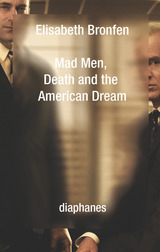
Mad Men, Death and the American Dream
Elisabeth Bronfen
Diaphanes, 2016
Matthew Weiner’s Emmy-winning series Mad Men has earned wide critical acclaim in its seven seasons. What is it about these impeccably dressed men and women of midcentury Madison Avenue that fascinates us? Decades later, when Weiner’s iconic characters seem as much a thing of the past as the workday martini, why is it so easy for modern viewers to commiserate with the reserved but ambitious Peggy Olson, to jeer at Pete Campbell, and to cheer on Don Draper in his often indecorous struggles?
We are drawn to Mad Men’s dapper cast of characters, argues Elisabeth Bronfen, because, although the series has drawn praise for its depiction of the 1960s and ’70s, it speaks equally well to cultural concerns of the present. The prototypical con man, Don makes a precarious journey from poverty to fame and prosperity that maps the pursuit of moral perfectionism that features prominently throughout American cultural history. Yet a lingering sense of dissatisfaction hints that the lifestyle Don strives for may be a mere manifestation of the illusory American dream—cemented in the same collective desires Don draws on to advertise cigarettes and luxury cars by day.
"Mad Men," Death and the American Dream takes readers through the cultural fantasies that underlie characters’ motivations in this sophisticated and immensely popular television series, showing how—then as now—we turn to fantasy in the face of conflicts that cannot be resolved in political reality. Fascinating and full of accessible insights, the book will appeal to the show’s many fans, as well as anyone interested in American studies, media studies, or cultural history.
We are drawn to Mad Men’s dapper cast of characters, argues Elisabeth Bronfen, because, although the series has drawn praise for its depiction of the 1960s and ’70s, it speaks equally well to cultural concerns of the present. The prototypical con man, Don makes a precarious journey from poverty to fame and prosperity that maps the pursuit of moral perfectionism that features prominently throughout American cultural history. Yet a lingering sense of dissatisfaction hints that the lifestyle Don strives for may be a mere manifestation of the illusory American dream—cemented in the same collective desires Don draws on to advertise cigarettes and luxury cars by day.
"Mad Men," Death and the American Dream takes readers through the cultural fantasies that underlie characters’ motivations in this sophisticated and immensely popular television series, showing how—then as now—we turn to fantasy in the face of conflicts that cannot be resolved in political reality. Fascinating and full of accessible insights, the book will appeal to the show’s many fans, as well as anyone interested in American studies, media studies, or cultural history.
[more]
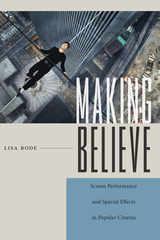
Making Believe
Screen Performance and Special Effects in Popular Cinema
Bode, Lisa
Rutgers University Press, 2017
In the past twenty years, we have seen the rise of digital effects cinema in which the human performer is entangled with animation, collaged with other performers, or inserted into perilous or fantastic situations and scenery. Making Believe sheds new light on these developments by historicizing screen performance within the context of visual and special effects cinema and technological change in Hollywood filmmaking, through the silent, early sound, and current digital eras.
Making Believe incorporates North American film reviews and editorials, actor and crew interviews, trade and fan magazine commentary, actor training manuals, and film production publicity materials to discuss the shifts in screen acting practice and philosophy around transfiguring makeup, doubles, motion capture, and acting to absent places or characters. Along the way it considers how performers and visual and special effects crew work together, and struggle with the industry, critics, and each other to define the aesthetic value of their work, in an industrial system of technological reproduction. Bode opens our eyes to the performing illusions we love and the tensions we experience in wanting to believe in spite of our knowledge that it is all make believe in the end.
Making Believe incorporates North American film reviews and editorials, actor and crew interviews, trade and fan magazine commentary, actor training manuals, and film production publicity materials to discuss the shifts in screen acting practice and philosophy around transfiguring makeup, doubles, motion capture, and acting to absent places or characters. Along the way it considers how performers and visual and special effects crew work together, and struggle with the industry, critics, and each other to define the aesthetic value of their work, in an industrial system of technological reproduction. Bode opens our eyes to the performing illusions we love and the tensions we experience in wanting to believe in spite of our knowledge that it is all make believe in the end.
[more]
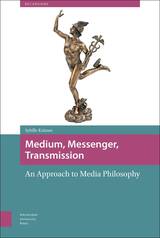
Medium, Messenger, Transmission
An Approach to Media Philosophy
Sybille Krämer
Amsterdam University Press, 2015
This rich study provides a comprehensive introduction to media philosophy while offering a new perspective on the concept and function of transmission media in all systems of exchange. Krämer uses the figure of the messenger as a key metaphor, examining a diverse range of transmission events, including the circulation of money, translation of languages, angelic visitations, spread of infectious diseases, and processes of transference and counter-transference that occur during psychoanalysis.
[more]
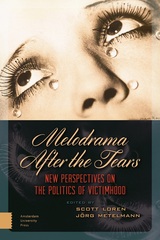
Melodrama After the Tears
New Perspectives on the Politics of Victimhood
Edited by Scott Loren and Jörg Metelmann
Amsterdam University Press, 2015
Melodrama, it is said, has expanded beyond the borders of genre and fiction to become a pervasive cultural mode. It encompasses distinct signifying practices and interpretive codes for meaning-making that help determine the parameters of identification and subject formation. From the public staging of personal suffering or the psychologization of the self in relation to consumer capitalism, to the emotionalization and sentimentalization of national politics, contributions to this volume address the following question: If melodramatic models of sense-making have become so culturally pervasive and emotionally persuasive, what is the political potential of melodramatic victimhood and where are its political limitations?This volume represents both a condensation and an expansion in the growing field of melodrama studies. It condenses elements of theory on melodrama by bringing into focus what it recognizes to be the locus for subjective identification within melodramatic narratives: the victim. On the other hand, it provides an expansion by going beyond the common methodology of primarily examining fictive works - be they from the stage, the screen or the written word - for their explicit or latent commentary on and connection to the historical contexts within which they are produced. Inspiration for the volume is rooted in a curiosity about melodramatic forms purported to increasingly characterize aspects of both the private and the social sphere in occidental and western-oriented societies.
[more]

Men, War and Film
The Calling Blighty Films of World War II
Steve Hawley
Intellect Books, 2022
A reclamation of a largely unknown genre of British wartime filmmaking.
The Calling Blighty series of films produced by the Combined Kinematograph Service around the end of World War II were one-reel films in which soldiers of the “Forgotten Army” gave short spoken messages to the camera as a means of connecting the front line and the home front. Shown in local cinemas, these were the first films in which men spoke openly in their regional accents, and they hold profound meaning for remembrance, documentary representation, and the ecology of film in wartime. Of the four hundred films made on the Far Eastern Front, only sixty-four survive. Until now, however, these films have barely been researched, despite being a valuable source of social history. This book expands the history of Calling Blighty, placing it in a broader context for contemporary audiences.
The Calling Blighty series of films produced by the Combined Kinematograph Service around the end of World War II were one-reel films in which soldiers of the “Forgotten Army” gave short spoken messages to the camera as a means of connecting the front line and the home front. Shown in local cinemas, these were the first films in which men spoke openly in their regional accents, and they hold profound meaning for remembrance, documentary representation, and the ecology of film in wartime. Of the four hundred films made on the Far Eastern Front, only sixty-four survive. Until now, however, these films have barely been researched, despite being a valuable source of social history. This book expands the history of Calling Blighty, placing it in a broader context for contemporary audiences.
[more]
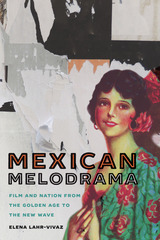
Mexican Melodrama
Film and Nation from the Golden Age to the New Wave
Elena Lahr-Vivaz
University of Arizona Press, 2016
In Mexican Melodrama, Elena Lahr-Vivaz explores the compelling ways that new-wave Mexican directors use the tropes and themes of Golden Age films to denounce the excesses of a nation characterized as a fragmented and fictitious construct. Analyzing big hits and quiet successes of both Golden Age and new-wave cinema, the author offers in each chapter a comparative reading of films from the two eras, considering, for instance, Amores perros (Love’s a Bitch, Alejandro González Iñárritu, 2000) alongside Nosotros los pobres (We the Poor, Ismael Rodríguez, 1947). Through such readings, Lahr-Vivaz examines how new-wave directors draw from a previous generation to produce meaning in the present.
Mexico’s Golden Age of film—the period from the 1930s to the 1950s—is considered “golden” due to both the prestige of the era’s stars and the critical and popular success of the films released. Golden Age directors often turned to the tropes of melodrama and allegory to offer spectators an image of an idealized Mexico and to spur the formation of a spectatorship united through shared tears and laughter. In contrast, Lahr-Vivaz demonstrates that new-wave directors of the 1990s and 2000s use the melodramatic mode to present a vision of fragmentation and to open a space for critical resistance. In so doing, new-wave directors highlight the limitations rather than the possibilities of a unified spectatorship, and point to the need for spectators to assume a critical stance in the face of the exigencies of the present.
Written in an accessible style, Mexican Melodrama offers a timely comparative analysis of critically acclaimed films that will serve as key referents in discussions of Mexican cinema for years to come.
Mexico’s Golden Age of film—the period from the 1930s to the 1950s—is considered “golden” due to both the prestige of the era’s stars and the critical and popular success of the films released. Golden Age directors often turned to the tropes of melodrama and allegory to offer spectators an image of an idealized Mexico and to spur the formation of a spectatorship united through shared tears and laughter. In contrast, Lahr-Vivaz demonstrates that new-wave directors of the 1990s and 2000s use the melodramatic mode to present a vision of fragmentation and to open a space for critical resistance. In so doing, new-wave directors highlight the limitations rather than the possibilities of a unified spectatorship, and point to the need for spectators to assume a critical stance in the face of the exigencies of the present.
Written in an accessible style, Mexican Melodrama offers a timely comparative analysis of critically acclaimed films that will serve as key referents in discussions of Mexican cinema for years to come.
[more]

Modern Argentine Masculinities
Edited by Carolina Rocha
Intellect Books, 2013
Setting new standards in assessing how masculinity in Argentina has been represented in film, literature, and music, this collection untangles Argentinian construction of masculinity, manhood, and gendered difference from the nineteenth century to the present. With methodologies ranging from literary analysis of novels to historical approaches to the construction and performance of gender, these essays offer a dramatic, new multidisciplinary approach to modern Argentinian masculinity.
[more]
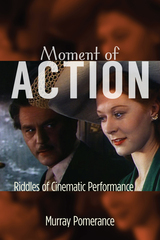
Moment of Action
Riddles of Cinematic Performance
Pomerance, Murray
Rutgers University Press, 2016
There are hundreds of biographies of filmstars and dozens of scholarly works on acting in general. But what about the ephemeral yet indelible moments when, for a brief scene or even just a single shot, an actor’s performance triggers a visceral response in the viewer?
Moment of Action delves into the mysteries of screen performance, revealing both the acting techniques and the technical apparatuses that coalesce in an instant of cinematic alchemy to create movie gold. Considering a range of acting styles while examining films as varied as Bringing Up Baby, Psycho, The Red Shoes, Godzilla, and The Bourne Identity, Murray Pomerance traces the common dynamics that work to structure the complex relationship between the act of cinematic performance and its eventual perception.
Mining the spaces where subjective and objective analyses merge, Pomerance offers both a deeply personal account of film viewership and a detailed examination of the intuitive gestures, orchestrated movements, and backstage maneuvers that go into creating those phenomenal moments onscreen. Moment of Action takes us on an innovative exploration of the nexus at which the actor’s keen skills spark and kindle the audience’s receptive energies.
[more]
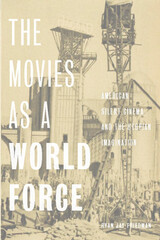
The Movies as a World Force
American Silent Cinema and the Utopian Imagination
Friedman, Ryan J
Rutgers University Press, 2019
Throughout the silent-feature era, American artists and intellectuals routinely described cinema as a force of global communion, a universal language promoting mutual understanding and harmonious coexistence amongst disparate groups of people. In the early 1920s, film-industry leaders began to espouse this utopian view, in order to claim for motion pictures an essentially uplifting social function. The Movies as a World Force examines the body of writing in which this understanding of cinema emerged and explores how it shaped particular silent films and their marketing campaigns. The utopian and universalist view of cinema, the book shows, represents a synthesis of New Age spirituality and the new liberalism. It provided a framework for the first official, written histories of American cinema and persisted as an advertising trope, even after the transition to sound made movies reliant on specific national languages.
[more]
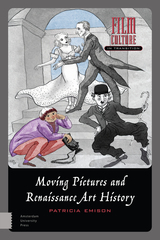
Moving Pictures and Renaissance Art History
Patricia Emison
Amsterdam University Press, 2021
Film, like the printed imagery inaugurated during the Renaissance, spread ideas---not least the idea of the power of visual art---across not only geographical and political divides but also strata of class and gender. Moving Pictures and Renaissance Art History examines the early flourishing of film, 1920s-mid-60s, as partly reprising the introduction of mass media in the Renaissance, allowing for innovation that reflected an art free of the control of a patron though required to attract a broad public. Rivalry between word and image, narrative and visual composition shifted in both cases toward acknowledging the compelling nature of the visual. The twentieth century also saw the development of the discipline of art history; transfusions between cinematic practice and art historical postulates and preoccupations are part of the story told here.
[more]

The Multisensory Film Experience
A Cognitive Model of Experiental Film Aesthetics
Luis Rocha Antunes
Intellect Books, 2016
When the lights dim in a movie theater and the projector begins to click and whir, the light and sounds of the motion picture become the gateway to a multisensory experience. Moving beyond the oft-discussed perceptual elements of vision and hearing, The Multisensory Film Experience analyzes temperature, pain, and balance in order to argue that it is the experience of film that’s inherently multisensory, not the medium. Luis Rocha Antunes here explores the work of well-loved filmmakers Erik Jensen, Gus Van Sant, and Ki-Duk Kim to offer new insights into how viewers experience films and understand their stories. This is an original contribution to an emerging field of research and will become essential reading for film scholars.
[more]
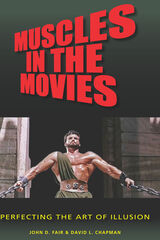
Muscles in the Movies
Perfecting the Art of Illusion
John D. Fair
University of Missouri Press, 2020
John Fair and David Chapman tell the story of how filmmakers use and manipulate the appearance and performances of muscular men and women to enhance the appeal of their productions. The authors show how this practice, deeply rooted in western epistemological traditions, evolved from the art of photography through magic lantern and stage shows into the motion picture industry, arguing that the sight of muscles in action induced a higher degree of viewer entertainment. From Eugen Sandow to Dwayne “The Rock” Johnson, muscular actors appear capable of performing the miraculous, and with the aid of stuntmen and filming contrivances, they do. By such means, muscles are used to perfect the art of illusion, inherent in movie-making from its earliest days.
[more]
READERS
Browse our collection.
PUBLISHERS
See BiblioVault's publisher services.
STUDENT SERVICES
Files for college accessibility offices.
UChicago Accessibility Resources
home | accessibility | search | about | contact us
BiblioVault ® 2001 - 2024
The University of Chicago Press









